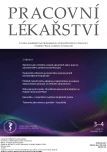Tularemia as an occupational disease
Authors:
P. Malenka
Authors‘ workplace:
Klinika pracovního lékařství, FN u sv. Anny v Brně a LF MU Brno
Published in:
Pracov. Lék., 73, 2021, No. 3-4, s. 91-94.
Category:
Case Report
Overview
The article summarizes the etiopathogenesis, diagnosis and treatment of tularemia, and describes the case reports of water managers who have recognized tularemia as an occupational disease at our clinic.
Keywords:
diagnosis – occupational disease – tularemia – etiopathogenesis
Sources
1. Beneš, J. Léčba tularemie v závislosti na formě a stadiu nemoci. Klin. Mikrobiol. Inf. Lék, 2000, 3, s. 79–83.
2. Benešová, E., Brhel, P., Fišmeisterová, B. K problematice profesionální tularémie. Pracovní lékařství, 2000, 2, s. 69–72.
3. Brejchová, H., Táborská, J., Špindlerová, A. Zvýšený výskyt tularemie v západočeském regionu. Prakt. Lék, 2000, 6, s. 322– 325.
4. Burke, D. S. Immunization against tularemia: analysis of the effectiveness of live Francisella tularensis vaccine in prevention of laboratory-acquired tularemia. J. Infect. Dis. 1977, 1, s. 55–60.
5. Černý, Z. Tularemie na jižní Moravě opět aktivnější. Klin. Mikrobiol. Inf. Lék., 2000, 3, s. 66–72.
6. Černý, Z. Výskyt tularémie a její klinické projevy v oblasti přírodního ohniska tularémie na jižní Moravě. Čas. lék. čes., 1978, 4, s. 105–110.
7. Forsman, M., Sandstrom, G., Jaurin, B. Identification of Francisella species and discrimination of type A and type B strains of F. tularensis by 16S rRNA analysis. Appl. Environ. Microbiol., 1990, 4, s. 949–955.
8. Hornick, R. Tularemia revisited. N. Engl. J. Med., 2001, 22, s. 1637–1639.
9. Janda, A., Fencl, F., Kabelka, Z., et al. Tularémie: vzácná příčina horečky a lymfadenopatie v kojeneckém věku. Čes.-slov. Pediat., 2000, 3, s. 173–175.
10. Karhukorpi, E. K., Karhukorpi, J. Rapid laboratory diagnosis of ulceroglandular tularemia with polymerase chain reaction. Scand. J. Infect. Dis., 2001, 5, s. 383–385.
11. Křepela, K., Pohl, J., Augustinová, A., et al. Tularémie – jedna z méně obvyklých příčin uzlinového syndromu a plicního postižení v dětském věku. Čes.-slov. Pediat., 1999, 9, s. 463–469.
12. Limaye, A. P., Hooper, C. J. Treatment of tularemia with fluoroquinolones: two cases and review. Clin. Infect. Dis., 1999, 4, s. 922–924.
13. Lobovská, A., Havlíčková, I., Aster, V. Tularemie – stále aktuální zoonóza. Klin. Mikrobiol. Inf. Lék., 2000, 3, s. 73–76.
14. Ludvíková, M., Beneš, Č., Petráš, P. Výskyt tularemie v České republice v roce 1998. Zprávy CEM, 1999, 3, s. 89–95.
15. Maurin, M., Gyuranecz, M. Tularaemia: clinical aspects in Europe. The Lancet Infectious Diseases, 2016, 1, s. 113–124.
16. Pellantová, V. Příspěvek k diagnostice a léčbě tularémie. Čes.- -slov. Pediat., 2000, 3, s. 173–175.
17. Prokešová, M., Bavlovič, J., Klimentová, J., et al. Tularémie – zoonóza s rizikem bioterorismu. Epidemiol. Mikrobiol. Imunol., 2019, 2, s. 82–89.
18. Provazník, K., et al. Manuál prevence v lékařské praxi. IV. Základy prevence infekčních onemocnění, Praha, Fortuna 1996, s. 118–119.
19. Sjostedt, A. Tularema: history, epidemiology, pathogen physiology and clinical manifestation. Annals of the New York Academy of Sciences, 2007, 1, s. 1–29.
20. Tarnvik A, Berglund L. Tularaemia. Eur. Respir. J., 2003, 2, s. 361– 373.
21. Vágnerová, I., Mikušková, E., Kohnová, I., et al. Kazuistika oroglandulární formy tularémie s překvapivým kultivačním záchytem Nokardií ve zkolikvované uzlině. Pediatrie pro Praxi 2005, 2, s. 95–97.
Labels
Hygiene and epidemiology Hyperbaric medicine Occupational medicineArticle was published in
Occupational Medicine

2021 Issue 3-4
Most read in this issue
- Monitoring of indoor air of operating rooms in practice in a tertiary-type medical facility
- Tularemia as an occupational disease
- Case report – (un)professional carpal tunnel syndrome
- Respiratory diseases in workers exposed to metalworking fluids
